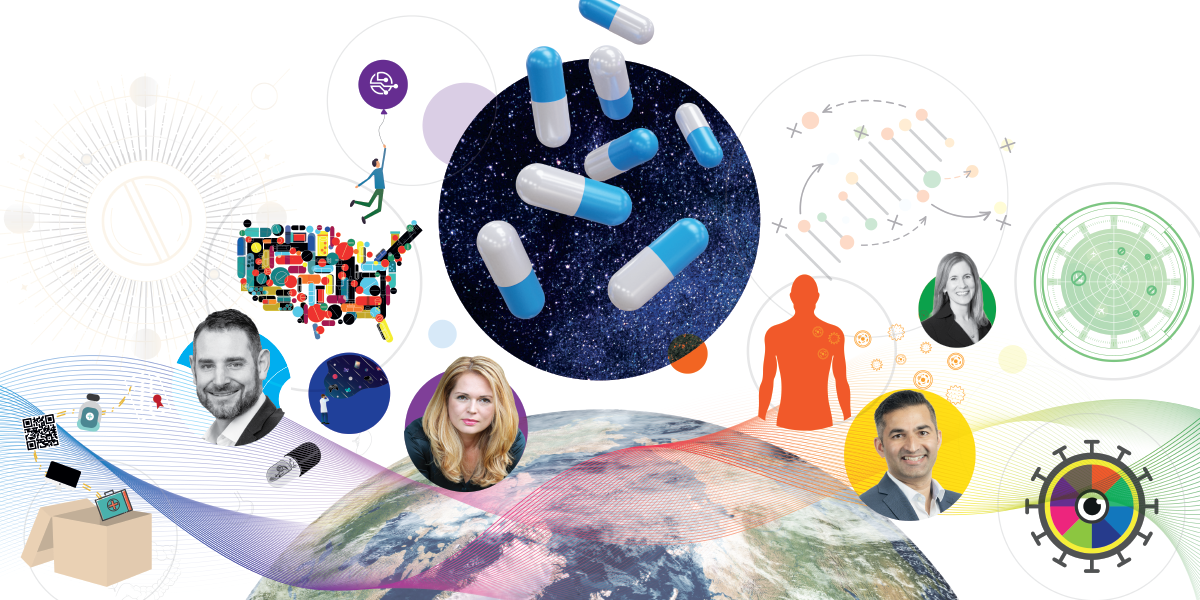The Multifaceted Future of Pharma – Chapter 7: Getting Smarter With Manufacturing
Read on for views on why sustainability, automation, AI, data and continuous processing will shape the future of manufacturing in the industry.
Read on for views on why sustainability, automation, AI, data and continuous processing will shape the future of manufacturing in the industry.
We asked: What has/have been the key disruptor(s) driving the industry over the past ten years, and how will this change in the next 10 years?

“The next decade will likely be dominated by trends we already see today. That is, increased personalized medicines, deployment of sustainable and green manufacturing processes, and the further integration of digital health. From an engineering standpoint, I also expect to see innovative approaches using AI and machine learning across all aspects of drug development – with a particular emphasis on manufacturing.
“The faster progress of drug development cycles using modular manufacturing is another area I expect to improve. By making smaller, more flexible manufacturing units that can be adapted to produce different drugs, we can ensure quicker response times to emerging health threats. Finally, I would like to see improvements in the regulatory side of our industry. Or, at least, a greater alignment of regulatory requirements across different regions to streamline global drug development and approval processes. This should not, however, be used as an excuse to hinder rigorous safety standards all should follow.”

“Over the next 10 years, there is so much opportunity for the industry to further advance drug development and manufacturing. From a drug development standpoint, one of the main barriers remains the regulatory complexity of entering various markets. The industry has come a long way recently to align and harmonize regulations, but further alignment would help support early phase programs.
“From a manufacturing standpoint, the industry continues to be impacted by long lead times and difficult supply chain issues. Single-use and ready-to-use technologies have drastically increased manufacturers’ capabilities to be flexible and nimble; however this can be impacted by slow moving supply chains. Eliminating cleaning validation or verification can allow programs to be transferred within a matter of weeks or months versus up to a year, and enables CDMOs to transfer in multiple products simultaneously. Additional capacity within the industry to support this initiative will drastically aid in the rapid advancement of early phase programs and get products to clinic and market much faster. Along these same lines, further advancement in the understanding of extractables and leachables to perform studies as efficiently as possible and potentially minimize future requirements would further facilitate the transition and adoption of single use technologies for all types of products in the industry.”
“The pharmaceutical and biotech industry has seen significant disruptions over the past decade, and this continues to rise. The next ten years will likely lead to more rapid innovation, improved patient outcomes, and a more efficient and sustainable ecosystem. Here are some top transformations I’ve noted in companies:
“Investing in climate and sustainability strategies. Over the last few years, companies have set net-zero or carbon-neutrality targets, and many have committed to reducing short-term greenhouse gas emissions. These initiatives can help achieve long-term sustainability goals, ensuring a healthier planet for future generations and addressing the risk of climate change on companies’ operations.
“Process digitization. Most pharma companies are digitizing their processes to become more agile, demanding much faster R&D timelines and integrating technologies such as AI, Internet of Things, or blockchain into their manufacturing process to enable faster time to market.
“Supply chain resilience. To reduce time to market, cost, and vendor dependency, companies have entirely changed how they look at supply chains. Earlier, procurement was mainly focused on getting the product at the lowest cost possible without compromising quality. But today, companies have realized the value of supply chain resilience compared to supply chain optimization in terms of price and timelines. As a result, many companies are using different supply chain sources to de-risk their source effectively.
“Adoption of AI and ML in drug development. In today’s context, where we are well-equipped with large datasets and high-tech computational capabilities, companies can use AI and ML to make data-driven decisions and accelerate the drug development process. With the advent of generative and predictive AI models, companies are leveraging historical datasets to improve the probability of success of a molecule.
“Regulatory reforms and accelerated approvals. Regulatory reforms like the FDA’s Breakthrough Therapy designation and the European Medicines Agency PRIME scheme are enabling faster pathways for drug approvals and quicker market entry.”
“As the pharmaceutical industry strives to create the drugs of the future, it is looking to open up new molecular space, and explore the potential of new modalities. Patient safety and quality remain paramount, and technology plays an important role in both the design of new drugs and their manufacture.
“A significant improvement within the industry could be achieved through the widespread implementation of AI and ML throughout the lifecycle of a molecule. These would allow the design of new drugs to be undertaken much quicker, with the virtual evaluation of numerous parameters to assess physical properties, potential side effects, and efficacy.
“Process optimization could be significantly enhanced, building on information from numerous sources to reduce the time spent undertaking real-time experiments. Screening processes in terms of hazard evaluation, and finding the optimal parameters with which to safely and efficiently manufacture products requires – and generates – vast amounts of data, and being able to concentrate the time spent by scientists and engineers to key steps will accelerate processes towards scale-up manufacturing.
“In manufacturing, these technologies could monitor processes in real time to ensure quality control of products during synthesis, as well as the reactors and equipment being used, reducing human involvement in maintenance schedules. Supply chains and procurement could be automated to avoid stock availability issues for key reagents and intermediates, reducing delays and potential shut down of manufacturing, and maintaining operational and delivery schedules.
“These technologies can dramatically accelerate the process of identifying and optimizing drug candidates, predicting clinical trial outcomes, and personalizing treatments, ultimately reducing costs, time, and improving the success rate of bringing new therapies to market.
“There is application of AI and ML already within some areas of the industry, but the setup of the technologies requires significant capital expenditure, and the models are dependent on the amount and quality of data that are available for them to draw on. We are potentially some distance away from seeing universal adoption, but we are seeing major players in the industry harnessing the potential of existing technology, and building systems to grow as the amount of data that can be accessed increases. While there is no substitute for human interaction and experience, technology must be leveraged where possible to make the design and manufacture of drugs safer and more efficient.”
“First of all, I want to see a focus on sustainability. The pharmaceutical sector is adversely contributing to planetary health in terms of greenhouse gas emissions, waste and impact on biodiversity. Hence, the big change required is for pharma and CDMO businesses to become carbon neutral or carbon positive in the near future. Ten years is too far out; change needs to happen now.
“Second, a great focus on patient centricity when it comes to self administration. Biologics need to be administered by injection or infusion to ensure systemic delivery and efficacy. Whilst the traditional focus of medicine has been economy of scale and the active ingredient, the patient has sometimes been forgotten. I hope that in the near- and mid-term, businesses will focus on patient usability, self-administration, and home treatment. This will increase patient comfort, adherence and compliance. It also has the potential to make a positive contribution to reduce overall healthcare costs.
“Third, with better patient pre-selection and screenings, another big trend is that it won’t be necessary for medicines to be produced in vast quantities. Commercially available medicines will be at the scale of a few thousand units per batch, or – at the extreme of personalized medicines – at a batch size of one. This requires capable, skilled and experienced manufacturers that can produce smaller amounts of products, while maximising yield. In addition, the variability of technical solutions (such as primary packaging and devices) is huge, so facilities that can implement and operate multiple primary packaging options will be key.”
“Several transformative changes would significantly impact the future of drug development, but three stand out as particularly exciting.
“Firstly, the potential of personalized medicine, and the shift towards treatments tailored to individual patients or genetic profiles, are not just promising, but are poised to revolutionize healthcare. In response, the International Consortium for Personalised Medicine (ICPerMed) predicts that the implementation of personalized medicine will lead to the next generation of healthcare by 2030. This approach promises earlier diagnosis, reduced adverse effects, and ultimately improved patient outcomes by leveraging developments in the biomedical, social, and economic sciences, together with technological advancements.
“Secondly, I would like to see a greater focus on sustainability in drug manufacturing to reduce our environmental impact. It’s crucial that we recognize the current resource-intensive and waste generating processes in the production of APIs. By increasing manufacturing efficiency, we can simultaneously reduce material and energy wastage, ultimately minimizing manufacturing costs.
“There are several proposed solutions to this challenge, including the repurposing of used solvents for incineration to generate heat, or performing oil recirculation to support the operation of essential processing equipment, such as vacuums, pumps, and compressors. Using recirculating oil, these systems can operate more efficiently, reducing energy consumption and associated emissions. Many companies are also seeking to reduce their physical footprints – opting for benchtop and flexible equipment, reducing requirements for large laboratories and manufacturing facilities to minimize environmental impact.
“The third change that would significantly impact the industry is the increasing role of AI and ML in drug development workflows. The potential of AI tools to predict drug efficacy and safety quickly and accurately is truly exciting, accelerating target discovery and accelerating preclinical testing. To fully realize this, we need comprehensive, reliable datasets and a collaborative approach to drug discovery. Open resources and communication between scientists and manufacturers would facilitate data sharing, unlocking the full potential of AI in drug development.”

“The pharmaceutical industry is affected by regulations like almost no other industry. Regardless of the requirements for ecological and social sustainability, we always have to fundamentally focus on patient safety. Furthermore, we are facing a rapidly changing world with a multitude of crises that will not disappear in the near future.
“We will not be able to meet these challenges with current production strategies, aimed primarily at optimizing existing processes from a cost perspective. Therefore, a fundamental revision of production strategies to find new solutions is essential to meet the challenges of sustainability, the increasing uncertainty of supply chains, and the disruptive changes in the industry. At the same time, therapies are being increasingly tailored to the individual needs of patients. This means smaller production batches and faster process conversion.
“To address all of these challenges, we must, above all, drive digitalization and automation forward. Digital production processes and smart factory concepts will enable us to respond more efficiently to the demands of personalized medicine. At the same time, digitized data analysis will help to process the large volumes of data arising from personalized medicine more quickly and to feed the results into production more efficiently. Both digitalized and automated production processes and the ability to process large amounts of data, also enable companies to operate in a more sustainable and resource-efficient manner and to respond with greater flexibility to crises.
“Flexibility is the bottom line. This also brings us to the concept of local4local, the second lever. In many manufacturing and production industries, we are seeing a shift towards local production. This is not least because of experiences surrounding the COVID-19 pandemic, though environmental disasters, trade conflicts, and geopolitical shifts also play a significant role. Local production for local markets and collaboration with local suppliers enables companies to be independent of supply chains, helps to monitor and comply with regulations, and makes sustainability easier.
“In a world facing profound changes, these are the decisive changes that we need in the next ten years.”

“The landscape of small molecule chemistry is evolving, moving away from the traditional constraints of Lipinski’s Rule of 5. For years, this rule has guided chemists to design molecules within certain complexity boundaries. However, today we witness an unprecedented diversity of structures in development portfolios with a growing percentage of non-classical small molecules. This includes highly complex bioisosteres, increased chirality, traditional and cyclic peptides, drug conjugates, and RNA therapies such as oligonucleotides.
“The increasing diversity and complexity of molecules, coupled with stringent development timelines, present significant challenges for process development scientists. The demand for robust commercial processes remains, and chemists are now facing more significant challenges than ever before. Overcoming these challenges will require cross-industry collaboration and the effective use of the full range of available technologies, including biocatalysis, synthetic biology, continuous processing, novel separation technologies, and membrane technologies.
“As we look to the future, the next decade promises to be both exciting and demanding. The increased variety in molecular design will push the boundaries of current methodologies, requiring innovative solutions and cooperation across various scientific disciplines. The journey ahead will undoubtedly test our capabilities but also drive remarkable advancements in the field.”
“Over the coming decade, one prominent category likely to drive substantial changes in drug development and manufacturing is AI. Coupled with AI, the areas that bring promising potential include age-appropriate and/or personalized therapies, orphan and rare disorders, real world data-driven decisions related to decentralized clinical trials, and enhanced sustainability in both manufacturing and supply chains.
“Ideally, drug development in the next decade should be driven by advanced delivery of large molecules, nucleic acids, and drug candidates for so-called “undruggable” targets through novel drug delivery technologies. As AI continues to turbo-charge discovery, development, and manufacturing elements, partnerships with CMOs and CDMOs, for example, will become all the more important in optimizing drug product design, development, and logistics for expedited time to market. Considering the advent and rapid proliferation of AI in drug development – and the need to provide patients with life-changing therapies as quickly as possible – augmentation and adaptations to current regulations in areas such as breakthrough, accelerated and fast-track pathways will be necessary.
“Regardless, all signs for the next decade point to customization, with drug manufacturing geared toward targeted, niche medicines produced in multi-product facilities offering potent and highly potent drug-handling capabilities, batch production flexibility, and agile and integrated manufacturing, testing and packaging services that bridge gaps between therapies and patients.
“Finally, the global drug manufacturing community has a shared responsibility to minimize greenhouse emissions, lower waste generation, and reduce water and energy consumption. The increased emphasis on environmental, social and governance issues across various aspects of the pharma sector has been highly encouraging.”

“The ongoing evolution of technology has many facets based on digital technology. When digitalization is applied intelligently, time to market is shortened, and engineering, construction, commissioning, and qualification activities are accelerated.
“Digital platforms enable the aggregation of massive amounts of data derived from various sources, such as engineering or process monitoring. Consistent, comprehensive, and detailed data acquisition, as well as the provision of this data in digital form (e.g., as a virtual image or digital twin of the bioprocessing plant), enables a significant increase in efficiency and pro-actively addresses numerous challenges in the domains of engineering, technology transfer, plant operation or maintenance. Efficient, holistic digitalization solutions significantly support companies to respond with the necessary agility, flexibility, and adaptability and, therefore, master these challenges.
“It is now possible to use a virtual image of the real world to make processes more efficient and stable, and to achieve leaps in productivity. Digital three-dimensional spaces not only allow for training in virtual facilities, but also enable employees to be guided through critical production steps using augmented reality. When coupled with simulation tools, current operational conditions can be displayed. Other scenarios can go beyond this, as simulations also look towards the future, allowing for the investigation of possible production scenarios.”

“The pressure to protect the environment has been a major driver of change in the pharmaceutical industry over the last decade. Looking to the next 10 years, it is clear that the emphasis on sustainability is here to stay. It will be crucial to develop strategies and infrastructures for the drug development and manufacturing industries that will enable lasting change. We need to see the adoption of sustainable practices to the point where they become the industry standard. CDMOs are key to the transition to low GWP propellants, offering the pharmaceutical industry the flexibility to innovate whilst keeping the ongoing supply chain operational.
“We will also need to see redrafted requirements for regulatory approval of reformulated products, including the need for new toxicity data. Timely regulatory guidance is crucial to support industry efforts to accelerate the transition to sustainable options.
“A significant transformation in the development and manufacture of pharmaceuticals is warranted in two key areas: the integration of circular economy principles and the implementation of product-embodied carbon assessments. Significant strides have been made over the last 10 years, but there is still a long way to go. The next 10 years will likely see some exciting advances as the industry works together to both develop innovations and create the strategies and infrastructure needed to ensure significant and lasting impact.
“In the next decade, we will need significant innovations in pharmaceutical packaging that emphasize sustainability and advanced technical solutions. Firstly, the adoption of recyclable materials for a circular economy will be decisive. Developing and integrating barrier packaging made of mono-material, such as mono PP, will reduce the ecological footprint, but these materials must still be designed to maintain the safety and stability requirements of pharmaceutical products.
“Secondly, smart packaging technology, especially automation and robotics, in packaging lines will also hopefully see advances; for example, AI-supported predictive maintenance could allow errors and signs of wear to be recognized and fixed before they cause problems. This minimizes downtimes, helping machines to remain productive for longer and work more efficiently. A significant role could also be played by AI-driven robots that can perform tasks such as sorting, filling, and sealing – enhancing precision and efficiency, minimizing human error and reducing material waste. Advanced robotics can also adapt to various packaging formats and sizes, offering flexibility and reducing the need for multiple machines, thus saving energy and resources.
“Furthermore, modular and adaptable packaging machinery will be essential. Machines that can quickly switch between different packaging formats and sizes without extensive downtime or reconfiguration will improve efficiency and reduce resource consumption. This flexibility will be particularly beneficial for small-batch production runs, which are becoming more common with personalized medicine.”
“I work on the supply chain side of the industry, so I’ll tackle this question from that angle. Transitioning from “just-in-time” to “just-in-case” is critical to help the industry navigate an increasingly volatile world. From prescriber demand outpacing chemical manufacture, to traceability limiting the speed of cross-border movement, there are a myriad of reasons that impact the supply of drugs to the people that need them.
“Firms must continually evaluate the likelihood and impact of risk to embed resilience into their operations.
“There are several major steps that can improve this. To start with, there is a lot of groundwork required (generally) in data improvement to be able to confidently answer the fundamental questions. Who is providing me with what data? How do I know it’s correct? How is this data going to be used across the organization to help people make the right decisions now and in the future? Have I got a system that’s going to improve efficiency and can the right people in the organization access it? When the answers to these questions are agreed, you can make demonstrable differences to lead times, availability, and inventory levels.
Another focus area is how you manage your key relationships. In a highly specialized industry, there isn’t an excess of suppliers out there who can deliver what you need. Taking the time to develop and invest in strong supplier partnerships and backing these up with secondary suppliers will help put firms at the front of the queue during times of limited capacity. Being clear on requirements, planning and forecasting will all help improve those strategic partnerships.”
“Clinically effective and safe cell and gene therapy products face significant manufacturing and development barriers. The unfortunate reality is that we have cures for cancer that most patients are unable to access. Manufacturing remains a critical barrier to scaling cell and gene therapies, limiting the clinical and commercial impact of life-saving therapies.
“Automation is crucial to overcoming barriers to scale. However, it’s essential to approach automation strategically – that is, not to automate for automation’s sake but for maximum impact. A modular approach may be the best way to provide the flexibility, scalability, and biological performance required to address the manufacturing bottlenecks of activation, transduction, and expansion. These are the longest, most manually intensive parts of the CGT workflow; addressing these with automation can significantly improve efficiency while delivering superior biological performance. The new generation of automation also plays a crucial role in supporting innovation in the industry by providing the scientific community with the flexibility needed to rapidly optimize their processes and the freedom to innovate where the first-generation manufacturing technologies have previously failed. In a field where a single failure can mean life or death for a patient, and where a batch can take weeks to produce, optimized workflows are critical to scaling the production of these life-saving therapies.”
“The pharma industry can and will take a quantum leap forward upon the convergence of two parallel trends: next-generation drug delivery and widespread adoption of automation practices. The former will revolutionize the ways in which patients access life-changing therapies; the latter will revolutionize the way brand owners and contract manufacturers produce them.
“Drug delivery techniques are in the midst of a “sophistication growth spurt,” comprising an increased trend toward – and refinement of – advanced delivery solutions including prefilled syringes and autoinjectors, novel nasal systems, and drug-device combination products that essentially erase the increasingly blurred lines between drug products and their customized administration apparatuses. Thanks in part to careful and precise drug targeting, local administration and individualized therapy, these systems are leading to safer, more effective treatments, and carry potential for improved therapeutic outcomes.
“Of course, developing and commercializing such next-level drug products presents a range of complex challenges. Though by no means a panacea, many of these hurdles can be overcome through the full-fledged embrace of automation technologies. Notably, the pharma industry at large has been heading in this direction for some time, prompted by a variety of root causes. For example, ongoing labor shortages continue to affect pharma manufacturers, pushing them toward automation. Also, companies are struggling to hire experienced mechanics and engineers to maintain equipment, prioritizing equipment that requires minimal maintenance and can be easily changed over by operators.
“But simply put, next-level drugs will require next-level automation solutions. Considering the niche markets such drugs tend to address, this means realizing the seemingly contradictory combination of automation and customization – for example, front-end automated filling and back-end automated inspection procedures for low-volume and potentially small batch size drugs.
“Over the longer-term, the gains are too compelling for technology not to advance to meet the moment. Streamlined, precision production, enhanced containment and sterility mechanisms, and other ancillary yet critical benefits will result from automation’s increased incorporation into advanced drug categories.”

“Getting drugs to patients faster relies upon the fidelity and speed of information transfer between stages of drug development. It is time for manufacturers to take a serious look at their approach to developing new products. Efficient, flexible clinical material supply supports quicker development and less manual technology transfer could speed commercial production.
“For the last two decades, the timeline from pilot process to commercialization scale and subsequent submission has remained largely unchanged. As more rapid clinical development approaches emerge, they reveal cumbersome, dated tech transfer processes that impact both manufacturers and patients. Further, the industry would benefit from additional FDA guidance, which exists for analytical tech transfer, but is lacking in process.
“Fortunately, technological advances offer opportunities to drive speed. The adoption of Pharma 4.0 approaches could allow knowledge transfer through automated interfaces designed to rapidly construct protocols, records, and reports. Using highly skilled professionals to slowly and painfully transfer knowledge is wasteful in a world where information can flow directly from an innovator to a manufacturer through software integration. Hours spent searching knowledge bases or creating draft documents can easily be cut short through the application of AI. Further, direct transfer of information reduces errors that would otherwise waste time and increase effort.
“Let’s set a target and drive for an 8-week tech transfer process before our slow analog approaches are painfully exposed by rapid clinical innovation! Let’s take advantage of current technology to better our systems, and call for updated guidance to help us deliver products and get patients out of the waiting room.”
“I anticipate significant drug development and manufacturing advancements focused on innovative drug delivery methods that enhance patient care. Self-administration options are evolving with the aim of improving the patient's quality of life. Collaboration between drug delivery device companies and CDMOs will further support pharmaceutical advancements in patient care.
“Additionally, a continued focus on sustainable and eco-friendly manufacturing practices within the industry is imperative. Striving to minimize waste, diminish energy consumption, and devise environmentally conscious packaging materials can significantly mitigate our ecological footprint and contribute to a healthier planet for future generations.
“Furthermore, enhanced collaboration and knowledge exchange within the industry are crucial to expediting the development of novel treatments. Fostering a culture of cooperation can cultivate a more innovative and streamlined drug development ecosystem, leading to expedited and cost-efficient medical breakthroughs.
“In summary, my aspirations for drug development and manufacturing center around the continual prioritization of patient care, environmental sustainability, and collaborative progress, ultimately culminating in a healthier and more equitable global landscape.”

“The speed at which we do business accelerates almost every day. Throughout my 40-year professional career, I've observed every aspect of the product development lifecycle change. Whether it's the time required to conduct studies, the speed of pharmacodynamic modeling, or even the swiftness of agency reviews for applications – nearly every process has become faster and more immediate.
“What's most interesting, however, is what hasn't changed. Regardless of how fast the chips move and how much data is analyzed by computers, humans are still essential for making sense of it all. It takes skilled individuals to determine the best strategies and assess the appropriate risk trade-offs. While we now have more data at our fingertips than ever before – which can sometimes feel overwhelming – it doesn’t have to be. We must remember that we are both artists and scientists, and knowledge fuels intuition. Today, practitioners in our industry are better educated, more capable, and more insightful than ever. Even though computers are faster and potentially more analytical, they can't always ‘see’ the data. People can and do.
“So, what has really changed? With all the tools, we do it better. We make better medicines, sooner and with improved efficacy. And our patients are the beneficiaries of this. I look forward to the next evolution in our thinking and am excited to see what the next ten years can bring.”
“Advancements in research and technology have pushed the pharmaceutical industry into an exciting era of unprecedented change. Over the next decade, developments in oral formulation technology could enable large molecules – such as insulin – to transition from intravenous to oral delivery, meaning greater patient convenience. Additionally, improvements in oral formulations of immunotherapies may provide a more accessible alternative to current intravenous cancer treatments to make home administration a reality.
“It would be impossible to talk about the future without mentioning artificial intelligence and machine learning. These tools have been touted as the next big thing in drug discovery and development, with a host of promising applications that could spread across the entire spectrum of our industry. Beyond this, I should also note that paving the way towards increased global regulatory harmonization is something we should all aim for; simplifying the approval process and reducing the need for multiple submissions is, above all, the only way we can ensure new therapies reach patients efficiently.”
“I would like to see a significant shift towards more sustainable and efficient manufacturing processes in drug development, adopting greener technologies and reducing the environmental impact of pharmaceutical production. Embracing eco-friendly practices is not only a moral imperative, it is a practical necessity for the industry’s long-term viability.
“By combining sustainable practices with cutting-edge manufacturing technologies, we can build a more resilient and efficient pharmaceutical industry. The widespread adoption of continuous manufacturing processes can improve product quality, reduce waste, and lower production costs. Continuous manufacturing can also enhance the scalability of drug production, improving timely access to life-saving medications.
“Greater collaboration between biotech startups and established pharma companies can also accelerate innovation and bring novel treatments to market faster. Nimble, innovative approaches can complement the vast resources of larger organizations, creating powerful synergies that benefit both the industry and patients.
“I hope to see a more patient-centric approach in drug development, where patient feedback and real-world data are integrated into every stage of the process. This can lead to the creation of treatments that are more effective, better tolerated, and tailored to the specific needs of diverse patient populations. As a healthcare provider and scientist, my ultimate goal is to improve patient outcomes and quality of life through innovative therapies and approaches.”
